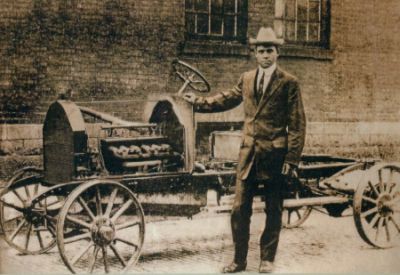Republished with permission from the Historic Vehicle Association
In the roughly 125 years during which the automobile has been manufactured in America, there have been thousands of companies that have come and gone. Some were barely a blip on the historical radar, while others have lasted well into the modern age. Yet in all these thousands of companies, African-Americans have only been the owners of one. And that company, the Patterson-Greenfield Automobile Company, existed for less than a decade some 100 years ago.
Near the end of the 1800s, carriage works manufacturers were proliferating across much of the Midwest. It seemed nearly every small town had its own, while the larger cities often had dozens. In southern Ohio, the town of Greenfield was home to J.P. Lowe & Company, a carriage works manufacturer which would go on to play an important role in the establishment of the first African-American-owned automobile manufacturer.
After having established his own carriage works in 1873, James P. Lowe enlisted the help of former Dines & Simpson carriage works foreman Charles R. Patterson. Born into slavery, Patterson worked his way to freedom, learning the coach building trade and, over the years, making a name for himself as a well-respected manufacturer. In an era stricken with racism, discrimination, segregation, etc. that he was African-American seemed to have little bearing on his reputation as one who produced carriages of high quality.
By 1893, Patterson was able to buy out Lowe’s share of the company, which he would soon rebrand as C.R. Patterson, Son & Co. Here he would employ his two sons, Frederick and Samuel, helping them learn the trade and further the company’s reputation. At their prime, C.R. Patterson, Son & Co. produced a reported 28 different vehicle styles, each ranging in price from $120 to $150, with a staff of only 10 to 15 employees. Sadly, Samuel would pass away in 1899 at the age of 23.
At the turn of the century, the horse-drawn carriage began to find itself replaced by the horseless carriage. All across the country, more and more people began falling for the automobile’s charm. Due to its rise in popularity and structural similarity to its non-motorized predecessor, many carriage works began moving away from the horseless variety and into the mechanized future.
Among those to leave the 19th century behind was the newly minted Patterson-Greenfield Automobile Company. Following the death of his father Charles in 1910, Frederick inherited C.R. Patterson, Son & Co. Seeing the writing on the wall, Frederick elected to begin manufacturing automobiles in 1914. It wasn’t until the following year that the first production model Patterson-Greenfield rolled out of the Greenfield, Ohio, factory.
A Patterson-Greenfield advertisementOffering two body styles – touring car or roadster – the Patterson-Greenfield featured a 30 horsepower Continental engine, electric starter and lighting, full floating rear axle, cantilever springs, demountable rims, and a split window designed for ventilation. Roughly comparable to the ubiquitous Model T, the Patterson-Greenfield sold for $850.
Unlike the Model T, however, the Patterson-Greenfield was advertised primarily in African-American-owned publications, chiefly Alexander’s Magazine and The Crisis, and was largely sold only regionally. One ad encouraged prospective buyers to: “…visit our factory. Glad to have you, Glad to show you how good we make this Patterson-Greenfield Automobile. It will pay you to come and look around.”
While later tallies would be inflated to around 150 vehicles having been manufactured, the true number is likely closer to 30. As with many of their contemporaries, Patterson-Greenfield soon found the cost of production less than sustainable. Because of this, the company produced their own automobiles for a short three years. By 1920 they had reorganized as the Greenfield Bus Body Co., and began manufacturing truck, bus and utility vehicle bodies installed on chassis from Ford, GM and handful of other, larger manufacturers.
Under the Greenfield Bus Body Co., Patterson managed to yet again make a name for himself by manufacturing some of the first buses used in the southern Ohio, Kentucky and West Virginia school districts. Throughout the next decade, the Greenfield Bus Body Co. ramped up production to meet the increasing demands for buses and other utility vehicles. The company continued to take and fill orders before folding in 1932 following the death of Frederick.
Sadly, as with many turn-of-the-century automobile manufacturers none of the original Patterson-Greenfield automobiles are known to have survived. All that is left are a handful of photographs and ads touting the construction and reliability of these historically significant automobiles.
(Anyone with any additional information on the Patterson-Greenfield company or its vehicles is asked to contact the HVA.)






As president of the Historical Society of Greenfield, Ohio I encourage you to check out our website for more information about C.R. Patterson and Company. Not only was he an automotive pioneer,C.R. fought for his son Frederick to attend the white high school and won. Frederick went on to Ohio State University and in 1899 was the first Afro-American player on the Buckeye football team.
We are always looking for more information about the Pattersons and always hoping that somewhere is that one last car.
Please contact via our website if you can help.